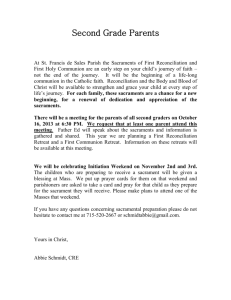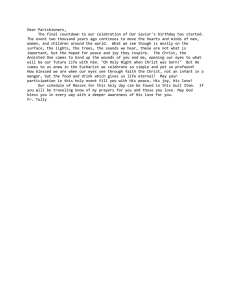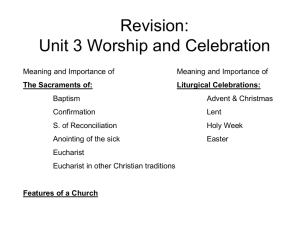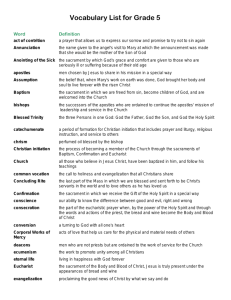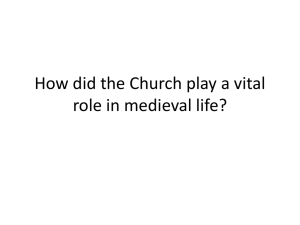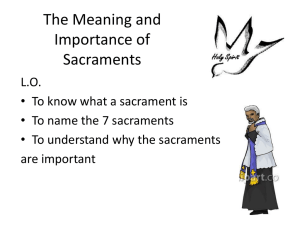The Sacraments of Christ What is a Sacrament?
advertisement
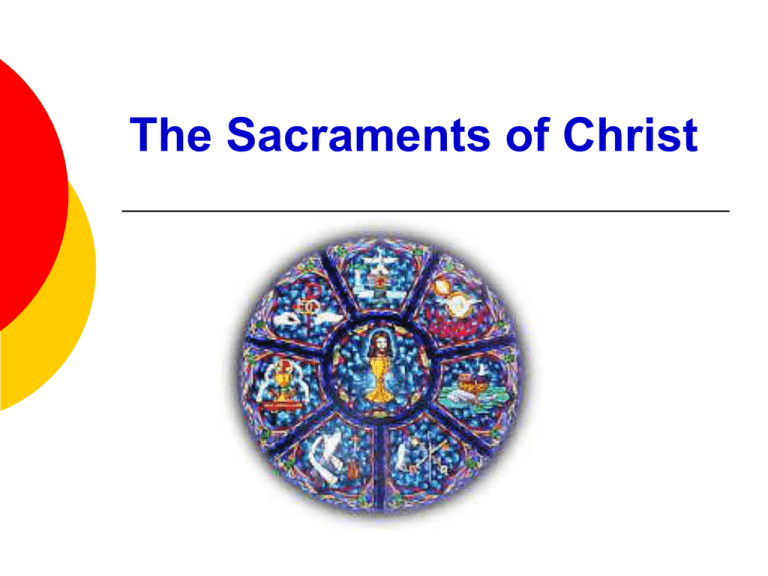
The Sacraments of Christ What is a Sacrament? A sacrament is an outward sign or symbol instituted by Christ to give grace. The grace we receive in a sacraments is a participation in the life of God. The whole liturgical life of the Church revolves around the Eucharistic sacrifice and the sacraments. Sacrament as Sign or Symbol St. Thomas Aquinas taught that human development is marked by seven stages which parallel the seven sacraments. We are born: Baptism We grow: Confirmation We are fed: Eucharist We are healed: Penance We recover: Anointing of the Sick We need and form family: Matrimony We need and respond to leaders: Holy Orders Signs and Symbols Sacraments ARE what they symbolize To be a sacrament, a sign or symbol must do the following: Lead us to God Come from God Be an action of God The best example of a sacrament is Jesus Christ himself. How do we make the sacraments known? The first and most important work of the Church is to make present Christ’s Paschal Mystery here and now. We do this in liturgy. All the sacraments are liturgy. Every sacrament is a community affair – an affair of the Church. Jesus is really present in Eucharist Jesus is present in the priest, the minister of the sacrament. Jesus is present when the Holy Scriptures are read. Jesus is present in the community assembled. Jesus is really present in the consecration of the bread and wine. The Church as Sacrament The Church is a mystery. The Church is beloved of Christ. The Church is an important symbol. Who Instituted the Sacraments? All of the sacraments were instituted by Jesus Christ our Lord. When did Jesus institute and sanctify the sacraments? During his life time here on earth. The Seven Sacraments The Sacraments of Initiation Baptism, Confirmation, Eucharist. The Sacraments of Healing Reconciliation, Anointing of the Sick. The Sacraments of Service Matrimony, Holy Orders. Sacraments of Initiation Baptism – brings new life in Christ. Confirmation – strengthens our new life with the gifts of the Holy Spirit. Eucharist – nourishes us with the Body and Blood of Christ. BAPTISM Instituted Jesus was baptized by John the Baptist and by his command to the apostles/disciples “Baptize all with water in the name of the Father, the Son and the Holy Spirit.” Sacramentals water Oil White cloth The Rite of Baptism Proper matter: Water Correct words: “I baptize you in the name of the Father, and of the Son, and of the Holy Spirit.” Designated minister: bishop, priest, or deacon Effects of Baptism Washes away original sin and any other sins and the punishment due. Makes us children of God and temples of the Holy Spirit. The Spirit of God is poured upon us in form of sanctifying grace Welcomes us as members of the Church, the Body of Christ. Marks us forever as sharers in Christ’s mission of justice and peace. CONFIRMATION Instituted Pentecost = when the Holy Spirit came upon the Apostles Sacramentals chrism Rite of Confirmation Proper matter: Chrism Correct words or form: Laying on of hands and anointing with chrism on the forehead with the words: "(Name), be sealed with the gift of the Holy Spirit." Designated minister: Bishop Effects of Confirmation oRoots us more deeply as sons of God oUnites us more firmly to Christ oIncreases the gifts of the Holy Spirit oRenders our bond with the Church oGives us a special strength to spread and defend the faith by word and action as true witnesses of Christ Eucharist Instituted Christ instituted the Eucharist during a Passover meal held at the Last Supper as a memorial of his Death and Resurrection. At the Council of Trent (1545 – 1563) the doctrine of transubstantiation was defined and the Roman Missal was published by Pope Pius V. Rite of Eucharist Proper matter: unleavened bread and wine Correct words: "Take this, all of you, and eat it: this is my body which will be given up for you . . Take this, all of you, and drink from it: this is the cup of my blood of the new and everlasting covenant. It will be shed for you and for all so that sins may be forgiven. Do this in memory of me.“ Designated minister: Bishop or priest Effects of Eucharist oNourishes the soul by giving us the strength to resist temptation oIt shows that Jesus is really with His people in the flesh oIncreases our life of grace oCleanses the soul of venial sins Sacramentals Bread Wine Sacraments of Healing Anointing of the Sick Reconciliation Our new life in Christ can be weakened by suffering, illness, death, and the effects of sin. Healing and Forgiveness Reconciliation Instituted When Jesus told the apostles’ “Whose sin you shall forgive in my name they are forgiven, whose sins you shall not forgive they are not forgiven” Rite of Reconciliation Correct words: “I absolve you from your sins in the name of the Father, and of the Son, and of the Holy Spirit” Designated minister: priest Elements of Reconciliation The acts the person undergoes The intervention of the Church Contrition Confession Absolution from the priest All Catholics are required to go to confession at least once per year to confess serious sins Effects of Reconciliation Penance reminds us that God is a loving God and forgiving friend Penance shows that God’s love is without limits He wants all of us to stop doing wrong and seek forgiveness Anointing of the Sick The sacrament encourages those who are sick to overcome the alienation caused by illness Jesus continues to bring healing through the prayers of the Church, and through the sacraments, especially the Eucharist and the Anointing of the Sick Anointing of the Sick Instituted By his own healing of the sick and when he sent the apostles out to preach and heal in his name Sacramentals oil Elements of Anointing of the Sick The priest or bishop • lays his hands on the sick person prays for the person in the faith of the Church anoints the forehead and hands of the sick person with oil previously blessed by a bishop Holy Orders Instituted At the Last Supper when he gave the apostle the command to be a servant to all and in His name the power to change bread and wine into his body and blood in his name Rite of Holy Orders Designated minister: bishop Elements of Holy Orders A call by God to serve the Church in a very special way. Essential rite includes: the laying on of hands by the bishop accompanied by a special prayer of consecration. An indelible spiritual character is conferred on the ordained man. Those who receive Holy Orders Holy Orders shows God’s desire that His family be cared for and served by leaders. Sacramental ordination consecrates certain baptized men to one of three degrees of a sacred order: Episcopate – bishops Presbyterate – priests Diaconate – deacons Matrimony Marriage is a sacred covenant --that is an agreement between the husband and wife, and between the couple and God. Elements of Matrimony The essential element of Matrimony is the mutual consent to marry. The words of consent must be freely given. Catholics must marry in the presence of a priest or a deacon, and in the presence of two witnesses. The spouses themselves are the ministers of the sacrament. The Seven Sacraments The sacraments celebrate Jesus as the Way, the Truth, and the Life. The sacraments are a way for us to live life to the fullest. The sacraments are the way to allow Jesus to touch our lives.

